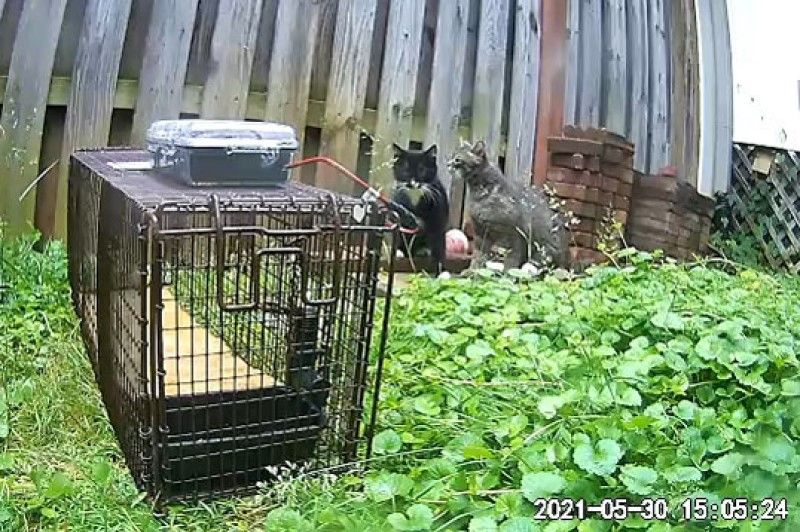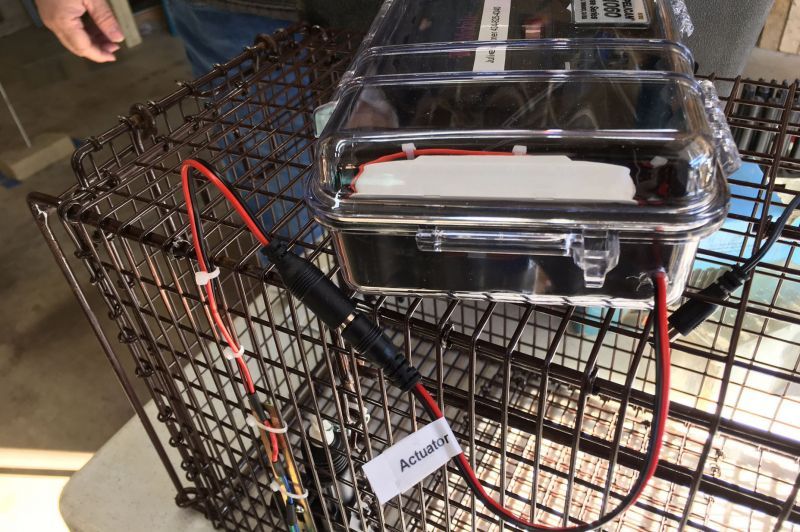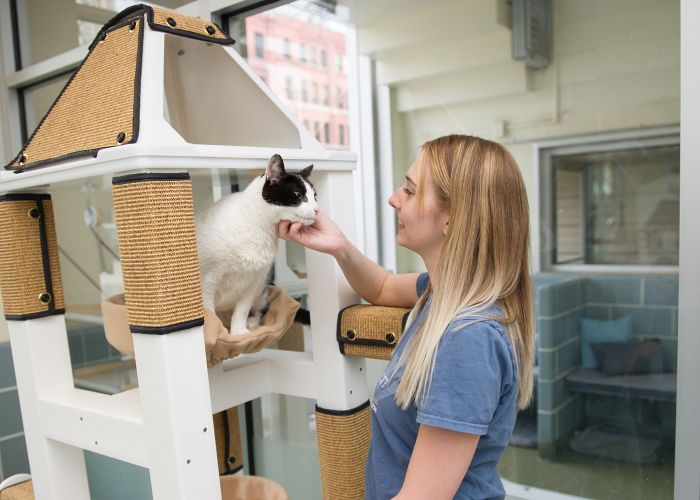Ask the expert: Bringing technology to TNR
South County Cats’ Deb Skilton Webster applies systems science to “robo-trap” elusive cats

Among South King County, Washington, trap-neuter-return insiders, Deb Skilton Webster is known as “The Closer”—the one called in to nab the holdouts and bring a cat colony to 100% sterilized status.
Webster joined the TNR cause in 2017, soon after retiring from her career as a mechanical engineer with The Boeing Company. It didn’t take long before she realized that, just like engineering projects, cat trapping can bring unexpected challenges.
One of her most challenging sites, a wooded gully dubbed Tuxedo Alley, involved four young kittens and an unneutered male who showed up at a recently TNR’d colony. It took many nights sitting in her car, holding a fishing line tied to the trap door, to get the kittens without catching the already sterilized cats. But the unneutered male came by so infrequently “that it eventually became clear that I was just never going to be able to catch him while sitting there in my car,” she says.
Unwilling to give up or spend the rest of her life on kitty stakeout in order to nab “Mr. Hard-to-Get,” she started researching ways she might monitor and trigger a trap remotely.
The result was what she calls a robo-trap, which combines a portable hot spot, a motion-sensitive livestreaming camera, and a trap outfitted with a Wi-Fi-enabled switch wired to a car door actuator connected to the trap’s trip lever. The setup allows Webster to monitor the trap from the comfort of her home and trigger the trap via a smartphone app once the target cat has ventured inside.

She set up her new contraption at Tuxedo Alley and spent the afternoon and evening watching the camera feed. Finally, at 1 a.m., a motion alert popped up on her phone. Expecting to see an opossum or raccoon, she opened the camera app “and there he was—my elusive unneutered male in the back of the trap just chowing down!” She hit the button on her phone that controlled the actuator and watched the trap door close.
“It worked like a charm the very first time in the field,” she says. “I got dressed, jumped in the car, and 15 minutes later had kitty safely secured in the back seat of my car. The trap was completely covered the entire time, and he was totally calm.”
Since then, Webster has used her invention to nab dozens of challenging felines. “There are some cases where the drop trap or the string-and-bottle method of selective trapping simply won’t cut it,” she says.
Last year, she started sharing robo-trap videos and building instructions on social media and got bombarded with questions from TNR advocates eager to add the technology to their trapping toolboxes. Close to 230,000 people watched one of her videos on TikTok, while the TNR Facebook page for Community Cats United hosts an ongoing discussion of camera options, battery packs, wire connectors and the like. “Just got my large male—last one in the colony,” one person commented. “I have been dreaming about this for YEARS, just didn’t have the knowledge to design it,” wrote another.
In this edited interview, Webster describes how she brought her own twist to cat trapping and her dreams for future innovations.
What motivated you to get involved in TNR?
Being a huge cat lover, in late 2015 I began volunteering as an adoption counselor for Purrfect Pals, a local rescue that focuses on senior and special needs cats. I worked in the cat adoption room at our local PetSmart, and the lead volunteer at that store also happened to be a volunteer trapper with South County Cats and invited me to a local TNR class.
I purchased a trap and went to the training, and while I found it fascinating, I was quite intimidated by how complicated and labor-intensive the whole process was. I decided that it would be best to wait until I retired before getting involved. Sure enough, shortly after I retired in 2017, I contacted South County Cats about volunteering.
How has your engineering background influenced your approach to trapping?
One of my mottos is “there’s an engineering solution to every problem,” and alas, there is most definitely no shortage of challenges when it comes to trapping feral cats!
Before the robo-trap, I was the first in our organization to look into camera options that would allow us to monitor traps remotely. For one of my first trapping jobs, I was recruited to help out with a very challenging site downtown. My fellow volunteers had an old-school trail cam that showed cats were on-site, but they only came around late at night. After weeks of multiple volunteers spending countless hours taking turns on kitty stakeout without success, I decided “there has to be a better way!”
There are live webcams all over the world, so I knew it could be done. While a camera alone wouldn’t allow me to select which cat in a group would get trapped, in situations where all the cats needed to be sterilized, the selective trapping capability wasn’t necessary. What the camera did was allow me to monitor traps from the comfort of my bed. We ended up trapping three cats at that site.

What were the biggest challenges to creating the robo-trap?
I started out by searching YouTube and found another trapper had already posted a video showing how he modified a Tomahawk trap using a car door actuator kit with remote. That was really the big breakthrough for me.
All I had to do was figure out how to connect an actuator to a Tru Catch trap and then figure out how to trigger it with a Wi-Fi switch instead of the car door remote. I already had a couple Wi-Fi hot spots for use with my Wyze cams, and Amazon had car door actuators, 12-volt Wi-Fi switches and 12-volt batteries.
In one very long night, I was able to wire everything up and put together a working trap.
“What the camera did was allow me to monitor traps from the comfort of my bed. We ended up trapping three cats at that site.”
—Deb Skilton Webster, South County Cats
Were you surprised by how many people used your plans to create their own robo-traps?
Yes, I’m really happy so many people have been able to use and adapt my designs to successfully build their own remote-control traps. It’s such a thrill to see them post pictures and videos of the cats they were able to catch.
I admit I was quite nervous putting my plans out there, because it’s definitely not a project for a novice-level hobbyist and can be quite the exercise in frustration for even the most tech-savvy individuals.
Many people are also disappointed when they find out it’s not something you can just go out and buy. All I can do is say, “I’m sorry, but you have to build it yourself.” And before you ask—no, I have no desire to get a patent on my invention, so if one of your readers is so inclined, they can have at it!
What other cat-trapping challenges could be addressed with technology?
There are so many! The real biggie for me is we need a way to track a mama cat to find out where she’s hidden her kittens. Some of the most stressful experiences of my life have been trying to find a litter of kittens that I knew was out there somewhere. I’ve looked into GPS collars, but the technology just isn’t there yet; they’re too bulky, and the battery life is short.
I know another rescuer who attached a Bluetooth tracker to a mama cat on a breakaway collar and found kittens that way. I looked into it a couple years ago, but I was worried the range would be too short to be useful. However, the devices are getting smaller and better all the time, so I’m seriously thinking about getting some.
My husband has also joked about developing facial recognition technology for animals that could recognize specific cats or automatically detect which cats are ear-tipped and trap the ones who aren’t. I admit I’ve even dreamed of having a drone with an infrared camera that I could fly at night, giving me an aerial view of the path that cats are traveling. Although they exist, they’re still pretty far out of my price range. Who knows, maybe someday!








